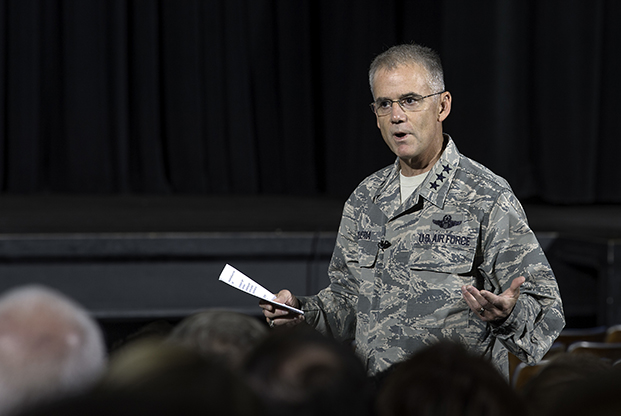
USAFA Superintendent Lt. Gen. Jay Silveria, shown here at an August 2018 Superintendent's All Call at the Academy, testified before the House Appropriations Committee's Defense subcommittee and the House Armed Services Committee's Military Personnel subcommittee on Feb. 13, 2019. Air Force photo by Darcie Ibidapo.
Air Force Academy Superintendent Lt. Gen. Jay Silveria detailed past, present, and planned initiatives to tackle sexual assault, sexual harassment, and culture- and climate-related issues at the school—including increased on-campus video surveillance and making more students who were expelled over sexual misbehavior repay the Air Force for the cost of their education—in testimony submitted to House legislators on Wednesday.
His Capitol Hill appearance followed the recent publication of a Defense Department report that found that almost half of USAFA’s female cadets were sexually harassed in the 2017-18 academic year, and that 15.1 percent of the same population experienced unwanted sexual contact in the same period. The report also called attention to “concerning climate-related trends” observed at USAFA.
In written testimony submitted to the House Armed Services Committee’s Military Personnel subcommittee on Wednesday and shared with Air Force Magazine, Silveria said “leadership is the solution” to the report’s findings concerning its climate, as well as the incidence of sexual assault and harassment experienced by its cadets, since “these are people, not statistics.”
“Sexual violence is about more than sex—it is about exploiting and manipulating disparities in power, and it is about control, and this behavior violates even the most minimal definition of respectful and dignified conduct,” Silveria wrote. “The bottom line is that if a person cannot adhere to our standards, they have no place at our Academy. They have no place in our Air Force.”
Silveria said steps being taken to address problems with the Academy’s “overall culture and climate” and to promote “good order and discipline,” beyond what was enumerated in the DOD report, include:
- Installing “several thousand” additional closed-circuit television cameras throughout the campus. Silveria said this ongoing initiative is meant to increase student “safety and security,” deter illegal behavior, and make footage available for investigators in case incidents do happen. These cameras aren’t located in “rooms or areas that would violate the privacy” of students, he said.
- A 2018 change to the Academy’s recoupment policy that allows the Air Force to charge students who get kicked out of the school over sexual misconduct “approximately $50,000 per year that the cadet attended the Academy,” regardless of their class year.
On top of USAF-wide disciplinary tools and courts-martial, the Academy has its own “cadet discipline system,” under which he is authorized to expel cadets over misconduct, Silveria said. This system also includes “boards of inquiry typically used for officer discharges,” he said. These boards simultaneously give victimized cadets who don’t want to make public testimony the chance to still have “a voice in a non-public setting,” while ensuring that accused individuals are still afforded “their due process rights,” he said.
In spring 2018, the school “replaced all personnel in the Sexual Assault Prevention and Response office, including the Sexual Assault Response Coordinator and all full-time victim advocates,” in addition to creating multiple new positions within the office, he said. The school also appointed the third-party firm College Sports Associates “to conduct an independent review of the culture and climate, risk management, and commitment to regulatory compliance within” USAFA’s athletics department in summer 2018 to give the school “an impartial, objective and exhaustive examination” of its athletics program, he said.
The resulting report praised USAFA’s standards for personal conduct and athletic performance, as well as leadership-development protocols, but also identified areas of potential improvement. In response to the report’s findings, he said, USAFA intends to:
- Hire and train an ombudsperson to act “as a resource for all staff and cadet-athletes” in the department.
- Put a campus-wide anonymous reporting option in place “as early as this summer” to allow cadets to blow the whistle on misconduct.
- Augment and expand coach and staff training.
- Work the school’s athlete code of conduct into a student-athlete handbook.
In a recent interview with Air Force Magazine, Air Force Secretary Heather Wilson highlighted the need for “more current data,” and to speed up its analysis to give service secretaries “a much better real-time picture” of where each service academy stands with respect to sexual harassment and assault.
She and Chief of Staff David Goldfein asked Silveria to review the DOD report’s findings and data, and to revisit existing programs—including those implemented “after these data were taken,” she said. In response to the report’s findings on cadet faith in cadet leadership, Wilson directed Silveria to have these peer leaders review the report’s data and self-reflect on the role they play in shaping their units’ culture.
“These are going to be lieutenants dealing with operational units, some of them within months or a few years,” Wilson said. “They, as young leaders, need to look carefully at the culture within their unit, as the cadet wing, and tell us what they think they can do to impact that culture.”
Wilson also said the nation’s service secretaries agree that the academies “need to lead on this issue,” for reasons including the wealth of relevant data they have access to and their track records of implementing programs to combat worrisome trends. This was the impetus behind the decision to have “the Naval Academy… host the first national summit on sexual assault prevention and response at” American higher-education institutions, with support from the Air Force, Army, and Navy, she said.